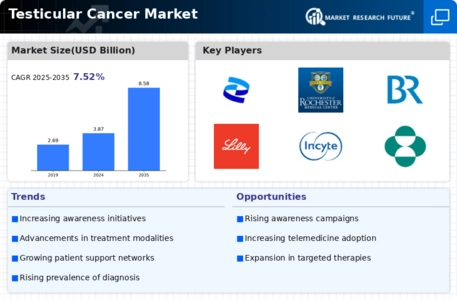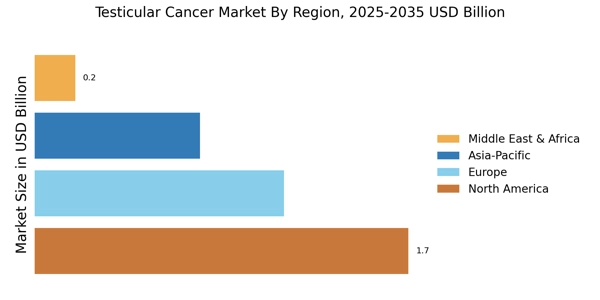Rising Incidence Rates
The Testicular Cancer Market is experiencing a notable increase in incidence rates, particularly among younger males aged 15 to 35. Recent statistics indicate that the incidence of testicular cancer has risen by approximately 1.5% annually over the past decade. This trend is likely attributed to various factors, including lifestyle changes and environmental influences. As awareness grows, more individuals are seeking medical attention, leading to earlier diagnoses and treatment. Consequently, this rising incidence is driving demand for innovative therapies and diagnostic tools within the Testicular Cancer Market, fostering growth opportunities for pharmaceutical companies and healthcare providers alike.
Increased Awareness and Education
Awareness campaigns and educational initiatives regarding testicular cancer have significantly impacted the Testicular Cancer Market. Organizations and healthcare professionals are actively promoting self-examinations and early detection strategies, which have led to a greater understanding of the disease among the target demographic. This heightened awareness is reflected in the increasing number of consultations and screenings, which have surged by over 20% in recent years. As more individuals recognize the importance of early detection, the demand for diagnostic services and treatment options is expected to rise, further propelling the Testicular Cancer Market.
Advancements in Treatment Modalities
The Testicular Cancer Market is witnessing rapid advancements in treatment modalities, including chemotherapy, radiation therapy, and surgical interventions. Recent developments in targeted therapies and immunotherapy have shown promising results, potentially improving patient outcomes and survival rates. For instance, the introduction of novel agents has been associated with a 10% increase in five-year survival rates for advanced testicular cancer cases. These innovations not only enhance treatment efficacy but also contribute to the overall growth of the Testicular Cancer Market, as healthcare providers seek to adopt the latest therapeutic options to improve patient care.
Integration of Digital Health Solutions
The integration of digital health solutions is transforming the Testicular Cancer Market by enhancing patient engagement and access to care. Telemedicine platforms and mobile health applications are facilitating remote consultations and follow-ups, making it easier for patients to manage their health. Recent surveys indicate that nearly 30% of patients prefer telehealth options for consultations related to testicular cancer. This shift not only improves patient convenience but also expands the reach of healthcare providers, ultimately driving growth in the Testicular Cancer Market as more individuals seek timely medical advice and treatment.
Growing Investment in Research and Development
Investment in research and development within the Testicular Cancer Market is on the rise, driven by the need for more effective treatment options and improved diagnostic tools. Pharmaceutical companies and research institutions are allocating substantial resources to explore novel therapies and understand the underlying mechanisms of testicular cancer. This trend is evidenced by a 15% increase in funding for testicular cancer research initiatives over the past few years. As new discoveries emerge, they are likely to translate into innovative products and services, thereby stimulating growth in the Testicular Cancer Market.


















Leave a Comment